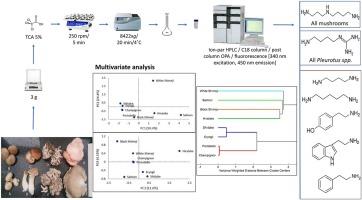Investigation of biologically active amines in some selected edible mushrooms |
| |
| Affiliation: | 1. LBqA - Laboratório de Bioquímica de Alimentos, Faculdade de Farmácia, Universidade Federal de Minas Gerais, Av. Antônio Carlos 6627, Belo Horizonte, MG, 31270-901, Brazil;2. Departamento de Química, Instituto de Ciências Exatas, Universidade Federal de Minas Gerais, Av. Antônio Carlos 6627, Belo Horizonte, MG, 31270-901, Brazil;3. Faculdade de Engenharia Química, Universidade Federal de Uberlândia, Campus Avançado Patos de Minas, Rua Padre Pavoni 290, Patos de Minas, MG, CEP 38701-002, Brazil;4. LCQ – Laboratório de Controle de Qualidade, Faculdade de Farmácia, Universidade Federal de Minas Gerais, Av. Antônio Carlos 6627, Belo Horizonte, MG, 31270-901, Brazil;1. Centro de Ciências Naturais e Humanas, Universidade Federal do ABC, Rua Santa Adélia 166, Vila São Pedro, Santo Andre, 09210-170, São Paulo, SP, Brazil;2. Empresa Brasileira de Pesquisa Agropecuária, Centro de Pesquisa Agropecuária de Clima Temperado, Estação Experimental Terras Baixas, Campus Universitário, 96001-970, Pelotas, RS, Brazil;1. Zhejiang Province Key Laboratory of Anesthesiology, Department of Anesthesiology, The Second Affiliated Hospital and Yuying Children’s Hospital of Wenzhou Medical University, Wenzhou, China;2. Collaborative Innovation Center of Seafood Deep Processing, Zhejiang Province Joint Key Laboratory of Aquatic Products Processing, Institute of Seafood, Zhejiang Gongshang University, Hangzhou, China;3. The Public Service Platform of South China Sea for R&D Marine Biomedicine Resources, Marine Biomedical Research Institute, Guangdong Medical University, Zhanjiang, China;4. School of Public Health, Guangdong Medical University, Dongguan, China;5. Aquatic Products Quality Inspection Center of Zhejiang Province, Hangzhou, China;1. Centre for Synaptic Plasticity, University of Bristol, Bristol BS1 3NY, UK;2. Inserm U1141/Université Paris Diderot Sorbonne Paris Cité/PremUP, Hôpital Robert Debré, 75019 Paris, France;1. Hebei Normal University of Science and Technology, Qinhuangdao, Hebei 066600, China;2. School of Chinese Medicine, Hong Kong Baptist University, Hong Kong, China;3. Food Science and Technology Program, Beijing Normal University–Hong Kong Baptist University United International College, Zhuhai, Guangdong 519085, China |
| |
| Abstract: | 
Mushrooms are highly valued due to nutritional and functional properties as well as small environmental footprint. However, scarce information is available regarding amines in commercial products. The objective of this study was to investigate the levels of bioactive amines in eight fresh edible commercial mushrooms species. An ion-pair HPLC method with post-column derivatization with o-phthalaldehyde and fluorescence detection was fit for the purpose. Seven out of nine amines were present and levels varied among species. Spermidine was ubiquitous to mushrooms, with highest content in Black Shimeji (12.4 mg/100 g). The levels of spermidine in mushrooms classify them as high polyamines sources, which is valued due to its association with growth, health promotion and antioxidant properties. Agmatine was present in all Pleurotus. Tyramine, tryptamine and phenylethylamine were detected in some species; the levels of cadaverine and putrescine were discrete. A four-principal component model explained 99.4% of the variance and it was able to separate Pleurotus spp. (White shimeji, Hiratake, Black shimeji and Salmon) from Agaricus bisporus (Champignon and Portobello) and Lentinula edodes (Shitake). Hierarchical cluster analysis confirmed the potential of using the occurrence and levels of amines to separate some mushroom species. |
| |
| Keywords: | Principal component analysis Hierarchical cluster analysis Spermidine Agmatine Polyamines Biogenic amines |
| 本文献已被 ScienceDirect 等数据库收录! |
|

